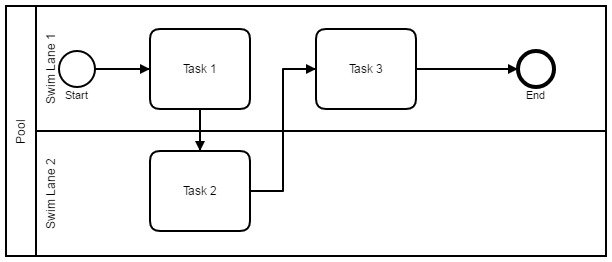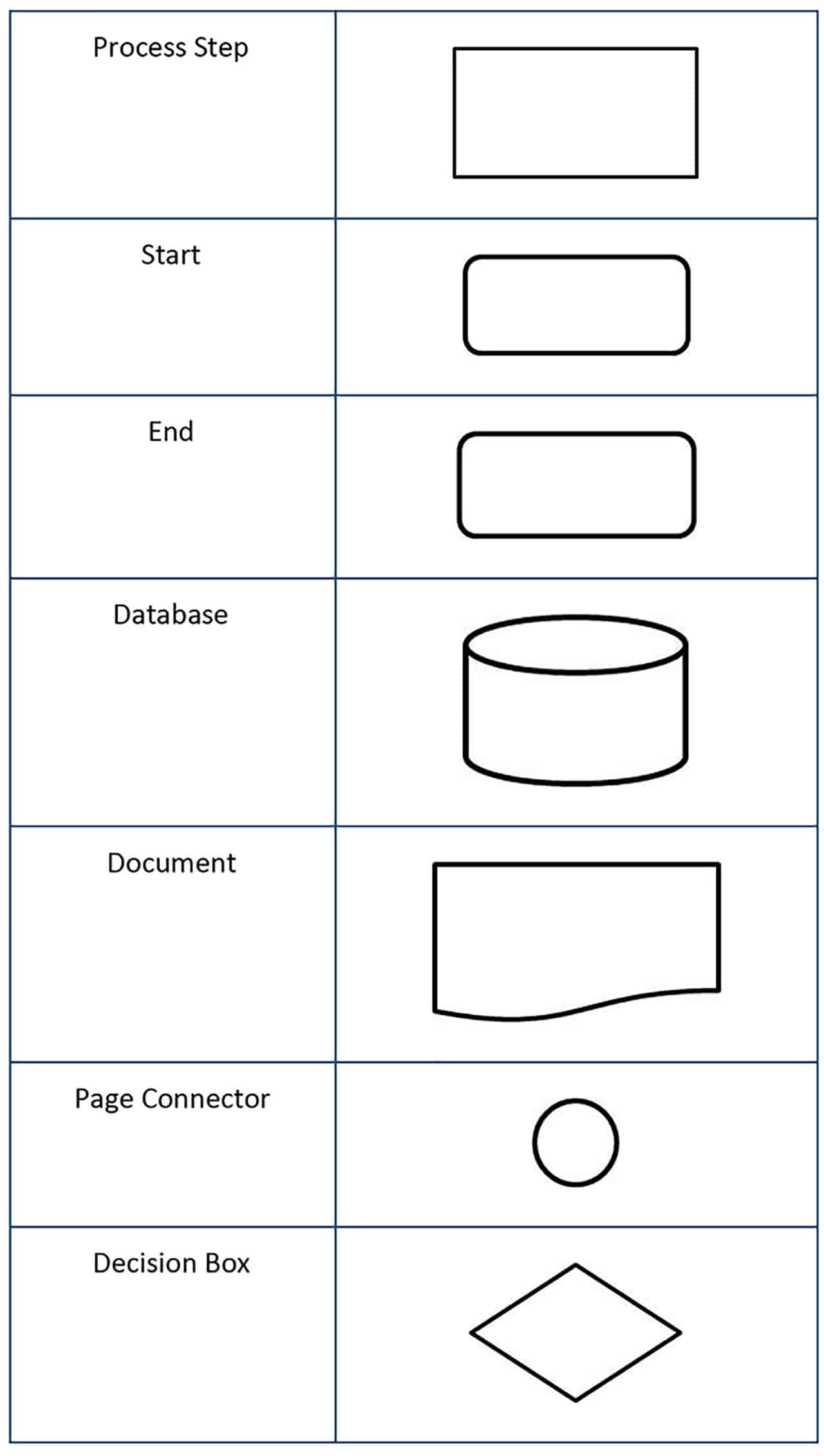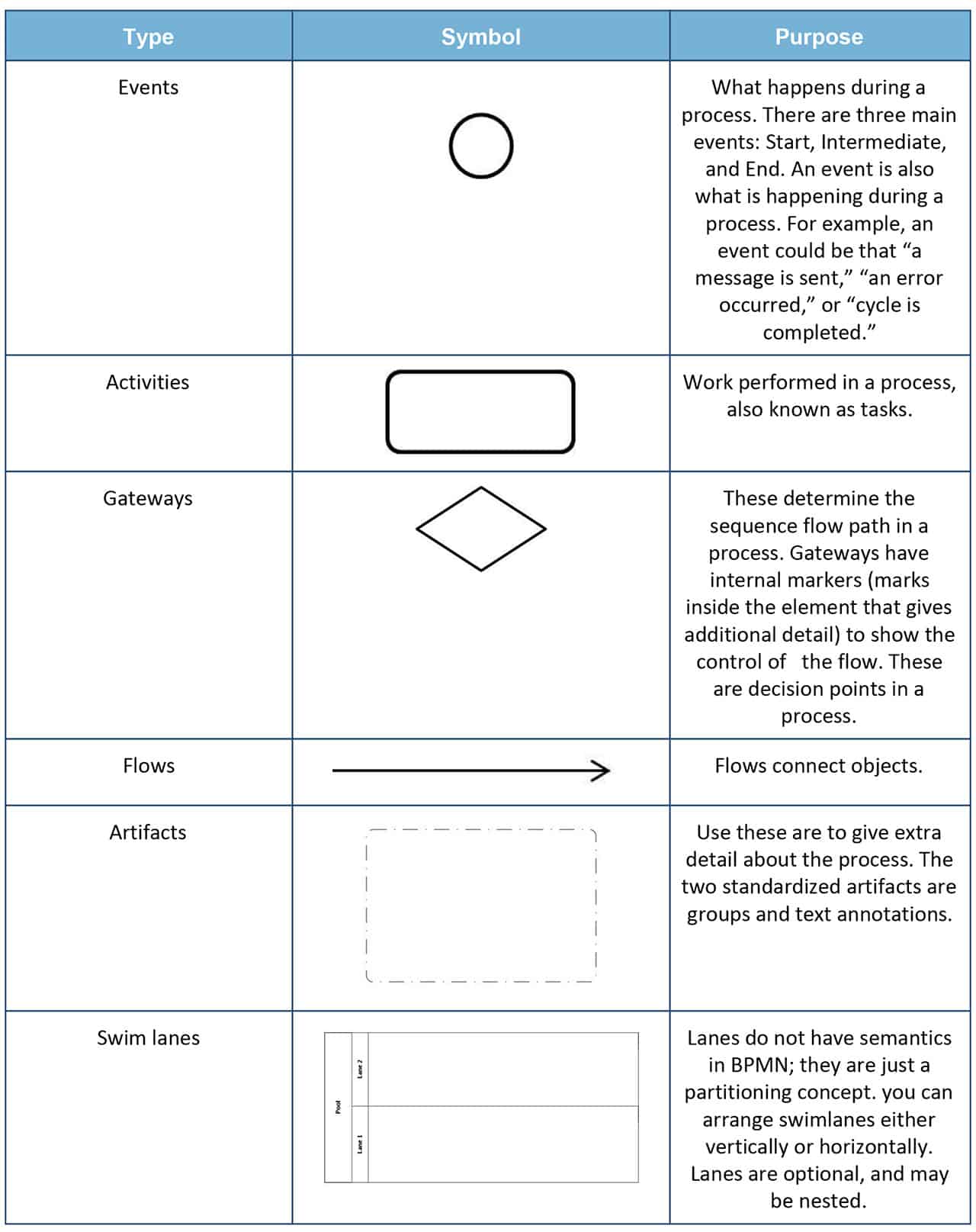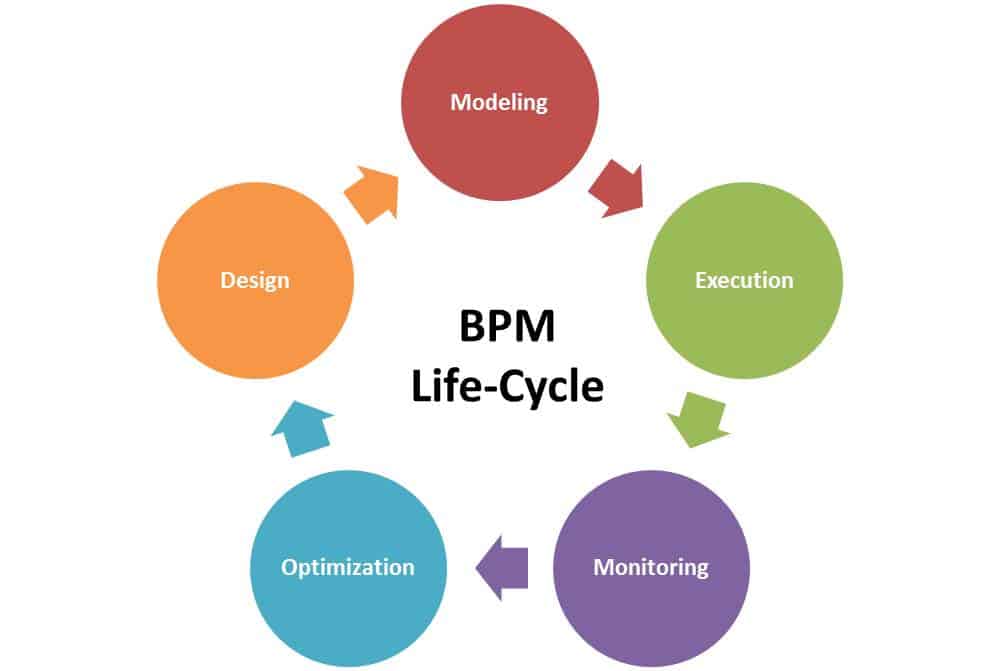What Is Business Process Mapping?
Business process mapping is a visual representation of work processes. Process maps show the relationship among the steps required to complete a product or service, and can be expressed as flowcharts or as Business Process Modeling and Notation (BPMN) symbols.
A part of business process management (BPM), business process maps are concerned with business activities, purpose, standards for success, roles and responsibilities, and when and where different steps will occur. Business process mapping promotes transparency, not only for those within the company, but also for all stakeholders, especially those involved in compliance.
Business process mapping is often mistaken for business process modeling. When professionals perform business process modeling, they are more interested in how the processes are performed, and who (or what department) is performing them. In this way, they focus on analyzing and optimizing the business process architecture through reviewing the processes and considering the company’s goals and requirements. A business’s process architecture details the entire enterprise’s set of processes. Often termed a “blueprint,” the architecture is typically used to align the company’s processes with their objectives. Modeling is more about how processes flow, while mapping is about what is in existence. For more information on business process modeling, see the Beginners Guide to Business Process Modeling.
See how Smartsheet can help you be more effective
Watch the demo to see how you can more effectively manage your team, projects, and processes with real-time work management in Smartsheet.
The Scope and Purpose of Business Process Modeling
Business process modeling is part of project planning for a wide range of project types. Businesses may choose to map their processes because they are conducting strategic planning, developing new metrics for reporting, or improving on their existing processes.
Process maps inspire professionals to consider how to make their organization more effective by thinking through their workflows. When you map a process, you must diagram it out in a way that achieves a shared understanding. The scope of business process mapping will show end-to-end activities, inputs such as materials or labor, and the linkages. A process map can cut across different departments and teams, and could even include external partners. It all depends on the process.
Organizations use business process modeling for different reasons, but primarily it’s a formal approach to quality management. Overall, businesses want to become more effective, so when all of the company objectives are measured and compared, it becomes possible to align them with your company’s values and capabilities. With aligned objectives, your organization can behave as a single entity with interconnecting parts, which significantly increases the value of your end-product or service. Other purposes of building business process maps include:
- Process standardization
- Employee onboarding and training
- Process improvement
- Communication
- Compliance with regulating agencies (e.g. International Organization for Standardization, 2002 Sarbanes-Oxley Act)
- Internal auditing
The History of Business Process Mapping
Business process mapping began with The American Society of Mechanical Engineers (ASME) in 1921. From there, engineers and manufacturing plants adopted business process maps and evolved them into the software solutions we have today.
In 1921, Frank and Lillian Gilbreth introduced the flow process chart in a presentation that they gave called “Process Charts, First Steps in Finding the One Best Way to Do Work.” (Purdue University has an archive of these materials, if you want to learn more.) The tools that the Gilbreth’s presented quickly became engineering standards and continued to be shown through the 1940s, having been sanctioned by the ASME. In 1947, the ASME adopted a symbol system for consistency in this type of chart.
The manufacturing industry also adopted process maps to identify value-add activities and inefficiencies. These maps often took days to create and were static. More recently, business process mapping has evolved with software development. Businesses can use software tools to create their maps quickly, evolve them over time, and make them accessible to all team members, facilitating a culture of improvement. Most business process mapping software integrates with business process management software systems, so that you can draw the maps and have them come to life within your business.
Types of Business Process Maps
You can create business process maps for project plans, details, documents, products, roles, locations, strategies, or interactions, at varying levels of detail. We’ve outlined the most common types of business process maps in the list below.
- Flowcharts: These are graphic illustrations of your process. Three types of flowcharts are popular: top-down flowcharts, deployment flowcharts, and detailed flowcharts. Top-down flowcharts show the steps of a process, clustering them together in a single flow. Deployment flowcharts are a top-down flowchart expanded to include who is performing each task. Detailed flowcharts are an expansion of both the top-down and deployment flowcharts, showing as many details as possible.
- Swimlane Diagrams: These diagrams, also known as cross-functional maps, detail the sub-process responsibilities in a process.
- State Diagrams: These diagrams show the behavior of systems in the Unified Modeling Language (UML), describing the states of component.
- Data Flow Diagram: Similar to a flowchart, this diagram focuses solely on the data that flows through a system.
- Value Stream Mapping: Part of Lean Manufacturing principles, value stream mapping demonstrates the current state and helps to design the future state of a process, focusing on taking products and services from their beginning to their completion.
The Reasons Why We Map Processes
There are many reasons that companies choose to map their business processes, including increased visibility, decreased errors in processes, and the ability to identify risk. The list below outlines some reasons your organization may decide to map its processes:
The Principles of Business Process Mapping
To properly transform your organization into a sustainable one, you must understand how we begin to map business processes. These following principles should be present in every mapping project:
- Define the scope of the project itself, with the boundaries, start, and end points.
- Look at the big picture - the intent of the process.
- Define each step clearly.
- Get feedback from everyone in your organization who is involved in the process.
- Strive to be complete in your accuracy, especially with the map of the “as-is” process.
- Strive to keep the sub-processes simple.
- Test the process with accepted metrics. Metrics should measure the time, volume, rates/costs, equipment, and any added value.
- Work from output to input, backward.
- Create ownership with single points of contact where feasible.
- Redesign processes to be customer-centric.
- Use technology to enable your processes.
- Decrease inefficiencies in the hand-offs.
The Framework of Business Process Mapping
To map your business process, first identify your business’s ideal processes. Then, define the purpose of the map. Analyze the process, optimize it, and then document the process while identifying problem areas. We’ve expanded on these steps below:
1. Identify your organization’s best practices: As in the principles of good business process mapping, your organization should agree on what is mapped and the scope of each. The process should be easily understood as mapped by someone who is not close to it. Each process should also have a series of questions posed to it that answer why it is being done and what goes into each detail of it. Finally, apply metrics as a basis for measuring the success of each process.
2. As-is in process design: Specifically define the purpose of mapping the process. Ask where the process initiates and ends, and determine what the opportunity of fixing it could become. After selecting a process, determine all the steps in it, as well as inputs and outputs. Establish the systems, roles, and time involved. Select a mapping technique. Interview the contributors for the roles they play in the process, looking at every duty and decision point.
The following are the specific criteria that you are looking for in every process:
- Responsibilities
- Objectives
- Activities
- Inputs
- Outputs
- Customers
- Risks and controls
- Key performance indicators
3. Analyze and evaluate: Review your process map. You are looking for processes that are redundant, delays and unnecessary steps, vagueness, bottlenecks, points of rework, and flows that continually pass back and forth between certain people. Determine a measure for each segment, and where exactly to implement it. Identify the appropriate people to review the map. Select a process improvement plan. Process innovation analyses should consider Steven Shapiro’s 7 R’s of process innovation:
- Rethink
- Reconfigure
- Resequence
- Relocate
- Reduce
- Reassign
- Retool
4. To-be in process design: Document the process, emphasizing any problem areas. Using the best practices developed in Step 1, document the differences in the existing and new processes. Use a root cause analysis to ferret out potential problems.
The Current State of Business Process Mapping
Businesses today are more focused than ever on sustainable improvement. Using software to map business processes allows companies to review and develop process maps more easily, so they can sustainably improve them.
Even with measurable operational improvements, it may be difficult to sustain the enhancements you make. Many businesses still have inefficient processes, and view technology as a magic bullet that can solve their woes in one shot. Experts say that while technology can certainly help, you need to use it judiciously in order for it to make lasting positive change.
Furthermore, the organization must make cultural improvements, since the development of technology for developing process maps has far surpassed most organizations’ ability to implement them. Without cultural shifts, the people who are involved in the process can easily sink the improvements before they even take hold.
The Symbology of Business Process Mapping
The standard notation for business process maps is known as Business Process Modeling and Notation (BPMN), but many businesses use a simpler form of notation. Many common software solutions support both BPMN symbols and their simpler counterparts.
We’ve summarized the BPMN symbols in the charts below:
Business Process Modeling and Notation (BPMN) is a different matter, however. BPMN is a much more formalized approach to mapping and modeling. Special software is required, and there is a learning curve in the use of BPMN. It is an extremely regulated language of notation, with specified symbols for almost any scenario. Mainly professionals who produce a lot of process models use BPMN. Across industries, countries, and languages, BPMN acts as a consistent way to identify the steps in processes. A more in-depth exploration of BPMN may be found in Beginners Guide to Business Process Modeling and Notation (BPMN). Some basic symbols of BPMN are inlcuded in the chart below.
Steps in Business Process Mapping
To map your business process, start by identifying the process to map. Gather information about the current process, and analyze it to determine where improvements can be made. Continue to monitor the process for improvement.
Performing the Business Process Mapping
In business process mapping, the processes you choose to map will determine how advantageous your maps are. Ensure that your business process maps are as impactful as possible by considering how they affect your customers and your overall business strategy.
We’ve outlined three methods for determining the most effective processes to map below:
- Group your processes based on their effect on your customer: These processes are core, enabling, and guiding processes. Core processes reflect the reason that the business exists, and have a direct effect on your clients. Enabling processes are those used in the management of the business. Guiding processes are those used in the planning and governance of the business. It is recommended in a process improvement project to start with either an enabling or guiding process so as you fine-tune your improvement method and do not impact your customers.
- Link your overarching strategy with your process and tasks: This starts with identifying your organization’s strategic goals. Once complete, you can form a process architecture based on it for your current processes. In this, you are determining what processes are most relevant to achieving your company’s strategy, and in what order to improve them to most keep in line with it and create a future agenda of improvement.
- Forced improvement: Less about a planned approach, this is more about reacting by necessity. For example, a failed audit or a management mandate can force a process improvement initiative. In this case, the required processes are targeted and mapped.
What Is Process Documentation and How Does Business Process Mapping Fit In?
Process documentation includes any documents that support or delineate a process. Business process maps are an element of process documentation that creates a visualization of how you perform your processes.
You can use process documentation as a roadmap for your organization to capture not only the end-products of your process improvement projects, but also how you got there. Decide how often you will update your process maps, and who will initiate new improvement projects. Another big component of process documentation is software documentation. Encourage users of all levels to use the software for the intended processes.
Business Process Management Life Cycle
The full BPM lifecycle is made up of unique business process improvement projects, and generally includes five phases: design, modeling, execution, monitoring, and optimization.
Business process management aims to systematically improve business processes. It is a cohesive agenda for the advancement of people and information with many components, including software. To learn more, see our guide to business process management.
Tips for Business Process Mapping
Business process mapping can be intimidating for first time users. We’ve collected expert tips, from recognizing your assumptions to using subject matter experts, in the list below:
- Apply business process mapping to the right types of processes. Processes that reflect how decisions are made may not be the best processes to map because they are limited in steps, and may not offer the most impact for your time.
- Be clear about the focus of your process mapping. Sometimes the inefficiencies in your processes are outside of the process itself. It then becomes critical that you review any intersecting (secondary) processes as well.
- Aim for good. There is no perfect. Enough said.
- Use care in cross-party responsibility process maps. These types of process maps are not the ideal, as the leading party is difficult to show graphically. Take care in the analysis to differentiate the leader when the process crosses boundaries.
- Get someone skilled to map your processes. Consider outside help if you do not have someone currently trained in mapping.
- Validate your maps. Right after you draw them, review them with the process participants so that you ensure they are correct.
- Be constantly aware of your assumptions. Your assumptions and those of your staff can get you into trouble. Keep asking the questions that reveal your biases.
- Don’t fix your processes until they are fully mapped. Define your ‘as-is’ state completely, ensuring that you see the whole picture and changes are then better informed.
- Remember that there are always exceptions and errors. Capture these, but remember that they may not be the norm and may not reflect the real as-is situation.
- The people who use the processes are the experts. It is critical that you have an appropriate overview because some people may be too close to change the processes, but they will be able to tell you whether the postulated changes have a chance of working.
- Collect all the documents from your improvement process. Improvement projects are not just about the map. Sure, it is important, but you may have to create it again.
“We are actually in the process of BP Mapping for our sales and marketing teams right now. It's important that we tie these different reports into a singular goal: Growth. To do that, we've employed some strict metrics in what we call a 5x3 Growth Plan. But the most important piece of advice I have for companies looking to invest in BPM is to RECORD AND MAP ALL OF YOUR PROCESSES BEFORE YOU START CHANGING THEM. Today's marketing world is in a flux of constant innovation and optimization. Because of this, we marketers are often hustling to implement, report, and optimize our tests all at one time. This simply doesn't work. I advise agencies employing business process modeling to slow down and make sure you get a complete and accurate picture of your business process before you start making changes. Crawl before you walk - and walk before you crawl - otherwise you'll end up tripping over your own optimization goals.”
“Companies that decide to map their processes should evaluate the top three to five processes to map first. Every company has several processes and they all need to be addressed. However, every process cannot be a top priority. It is best for companies to evaluate the top company-impacting pain points, evaluate which points need process definition, and structure a process to solve that pain point. If there is a process that is revenue generating or negative impacting, those should rise to the top of the priority list. As a company is able to develop more and more process, the company injects more stability and growth potential.
“The first process selected to be mapped should be the largest pain point in the business which restricts revenue generation. Every business is going to have obstacles and pain points to have growth. An efficiently run business is a successful business and successful businesses have significant revenue. Revenue generation keeps the business moving forward so a company should want to remove all obstacles slowing the acquisition of revenue.”
“The technical capacity of BPM has dramatically outpaced the level of adoption or even awareness of the field. Most companies have never done any process mapping -- not even informally -- and they suffer from poorly-defined procedures, minimal staff engagement, and significant rework and duplication.
“Your time is the most important investment, and purchasing software or hiring consultants won’t help if your team isn’t truly committed to process mapping. Learn one or two of the UML forms. I suggest using case diagrams and activity diagrams. Practice these extensively with fun, non-work processes like planning a party or scoring a frame of bowling. Once you learn the technology of process mapping, you’ve got a fighting chance of implementing it in your organization.
“We’ve done process mapping for all kinds of organizations, from marketing firms to factories to logistics companies. In most cases, the experience requires sitting down with staff directly and watching them work to learn about the procedures. This is the only accurate method to document the as-is state of the organization. Training materials, manuals, and even what management says is usually outdated or flat wrong.
“It’s good to select a low-impact, high-visibility process to highlight the capacity and utility of mapping. From there, the next step is to develop a lexicon for the organization. This is the terminology that people use to describe activities and work product. Then, we’re most interested in processes that cross teams or departments. That’s usually the area where there is the biggest disconnect and the most challenges.”
“Business process mapping is a very important part of setting up a new business or just a new part of a business. You have to know who is going to do what and at what level of efficiency and quality because if they aren't meeting those needs your business could fail right out of the gate.
“My best advice is make sure you have every little thing mapped out, even to who will be getting the coffee for the office, you want your office to be moving as smoothly as possible to make sure there are no kinks. Especially when starting something new, it has to move quickly and effectively to be successful.
“We just recently finished recruiting our teams for our new magazine, Wundr Magazine, which is an entity of Wundr Media. When doing so we had to map out every single thing from editors to journalists and content creators along with managing trips and photoshoots to make sure everyone is doing their job to the highest level possible. The way I chose to map my processes was to decide on which is the most important and what would fail if we didn't get it exactly right from the start. For us it was marketing, of course. If a tree falls in a forest and no one hears it, does it make a sound? Or if a magazine launches and no one knows about it, does it even exist?”
“Business process mapping has been high on most lists of important business sustainable growth plans throughout the last year. It is a logical continuation of deliberate investment into the improvement of business processes. The demand for business process mapping is slowly and steadily picking up. The business owners and leaders have understood the value of optimized business processes as an essential part of their overall success. According to a recent study by AIIM, most businesses see business process mapping as a systematic approach to improving their processes. However, less than half of the business owners really know all they need to about business process mapping. While they show a positive attitude toward adopting business process mapping for their businesses, most of them cite stuck-in-process as the biggest reason for failing to implement business process mapping. Increasing awareness about business automation however increases the scope of adoption of business process mapping among the business and technology leaders."
In the field of marketing, business process maps are called journey maps. These journey maps are based on the customer’s perspective and transform complex data into a one-page visual diagram.
- Acquisition - How do we get customers to our site?
- Activation - How do we get them to sign up?
- Retention - How do we get them to stay?
- Revenue - How do we make money?
- Referral - How do we use those customers to get more customers?
“Starting with the gap from customers visiting our site and signup up for our service, we utilize a few different tools to enter them into a journey. Our live chat and eBook are at the forefront of the mix. We use these to get more information on who they are and what pain points they are having. Once we get their contact information, we enter them into a journey decided upon by the sales person or the lead form they filled out. For example, if they are fulfilling orders in-house, we'll send them information on how to transition to outsourcing and the benefits associated, free consultations, signs to outsource, etc. If they are using another fulfillment center, we'll sell them on what ShipMonk specifically does better. If they are just getting started we'll give them information on how to get started themselves and when to consider outsourcing.
“Once we get customers to sign up, our focus is solely on retaining them. It costs five to seven times more to gain a new customer than to retain a current customer so this is very important. We send milestone emails and rewards each time a customer reaches a certain number of packages shipped and we check it every few months to make sure everything is going as they've hoped. We proactively try to stay ahead of issues before they boil out of control. This is all done through marketing automation and timed in a behavioral journey.
“Revenue - We have partners who have services that benefit our customers and if we see an opportunity that would benefit our customers first, we'll enter them into another journey to promote a partner service. If they aren't interested, we remove them from the journey immediately and move on. Our goal is to help our customers sell and ship more packages. If they sell more we ship more.
“Referral - It’s pretty simple, if you have a good product or service people will be willing to let others know and write a review. The problem is most people are extremely busy and don't think to write a review unless they are unhappy. We use journeys to remind customers of the review and what it would mean to our business.”
“Business process modeling and mapping can seem daunting at first. Which process should you start with? The answer is: Which process needs the most attention? Company or initiative strategies comes into play, but that may only tell you the general direction to go. In that case, or in the case of initiatives containing multiple processes, it's a good idea to refine your search. There are tools that I like to achieve focus: the SIPOC and the Process Performance & Process Capability calculations. A SIPOC can give you a high-level end-to-end view of your process. Often by examining the interactions on the ends, the suppliers and consumers, it's obvious which process to begin to model. Process Capability and Process Performance calculations give us common language to measure processes against each other - even if they are wildly different. Once we have a way to quantitatively measure processes, we can then choose to model the worst-performing process in order to begin to see how we might improve it, which would then improve the whole.”
“Business Process Mapping is an excellent way to get started on a journey of continuous improvement. How can we improve if we don’t know our starting point? We can’t! So, the first step is understanding our current level of performance. To this end, we need to know what our current processes are and how to measure their performance.
“Each company has core processes that are essential for achieving the company’s strategy. For example, in an insurance company, the claims process is absolutely critical, and could be a good starting point for process mapping. In a manufacturing company, planning and scheduling is essential, and could be an excellent starting point. Pick something that is important, so that the time spent on documenting and evaluating the process is viewed as beneficial.
“To map the process, work with a team of individuals who do the work on a daily basis. They’re the ones who know how the process is really working, and what are the potential issues. Some key questions to ask include:
- What are the process steps from beginning to end?
- What function is responsible for each step in the process?
- How do we measure the performance of each process?
“No investment is needed to get started. The team can begin with just a stack of sticky notes on a white board, and once the process is determined, document it for future reference in a software program that the company is already using. Through the exercise of working with the team on business process mapping, many process improvement ideas will surface. You’ll be amazed at all of the good ideas that team members have on how things could be done better. Now is the perfect time to get started!”
Business Process Mapping: Tools and Software
Depending on the long-term needs of your business, you may consider purchasing business process mapping software and tools. It is important to determine what features are available and find a solution that fits the needs of your team.
We’ve made a list of popular features for your consideration below:
- Drag-and-drop interface
- Formatting capabilities
- Integrated BPM tool
- Publishing and sharing capabilities
- BPM app
- Venn diagram maker
- Mind mapping software
- Data flow diagram software
- Intuitive design
- Automated updates
- Integration with MS Office products
- Graham process maps
- Linking between charts and other documents
- Reporting capabilities
- Review scheduling capacity
- Web-based
- Unified platforms
- Collaboration
- Business rules management
- Process analysis
- Process simulation
How Smartsheet Can Help Improve Business Processes
Empower your people to go above and beyond with a flexible platform designed to match the needs of your team — and adapt as those needs change.
The Smartsheet platform makes it easy to plan, capture, manage, and report on work from anywhere, helping your team be more effective and get more done. Report on key metrics and get real-time visibility into work as it happens with roll-up reports, dashboards, and automated workflows built to keep your team connected and informed.
When teams have clarity into the work getting done, there’s no telling how much more they can accomplish in the same amount of time. Try Smartsheet for free, today.













